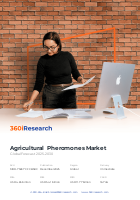
Agricultural Pheromones Market by Product Type (Aggregation Pheromones, Alarm Pheromones, Sex Pheromones), Function (Attract-and-Kill, Mass Trapping, Mating Disruption), Pest Type, Source, Formulation, Crop, Application Method, End User, Distribution Channel - Global Forecast 2025-2030
SKU
MRR-732E7CFCB58C
Region
Global
Publication Date
December 2025
Delivery
Immediate
2024
USD 4.65 billion
2025
USD 5.41 billion
2030
USD 11.77 billion
CAGR
16.74%

Download a Free PDF
Get a sneak peek into the valuable insights and in-depth analysis featured in our comprehensive agricultural pheromones market report. Download now to stay ahead in the industry! Need more tailored information? Ketan is here to help you find exactly what you need.



